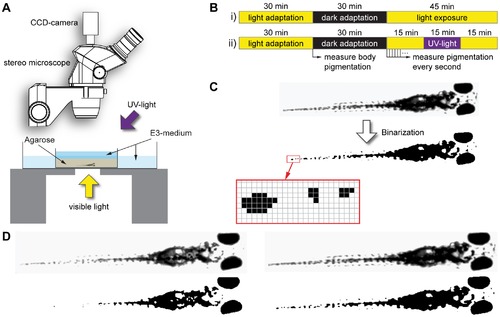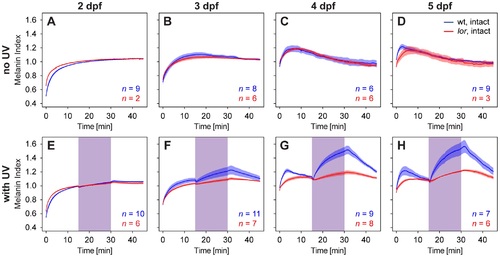- Title
-
Sunscreen for fish: co-option of UV light protection for camouflage
- Authors
- Mueller, K.P., and Neuhauss, S.C.
- Source
- Full text @ PLoS One
|
Experimental procedure. A) Schematic drawing of the experimental setup. Zebrafish larvae are embedded in agarose and placed under a dissecting microscope. Illumination with visible light is provided from below, optional near-ultraviolet light from obliquely above. B) After an initial light adaptation period lasting 30 minutes, the extent of body pigmentation is measured and serves as a reference for all following measurements. The larvae are then dark adapted for another 30 minutes, after which they are exposed to visible light for 45 minutes (i). During light exposure, the extent of pigmentation is measured every second. Optional UV light is provided during a 15 minutes interval in the middle of the light exposure phase (ii). C) To quantify the extent of body pigmentation, images of the larva are binarized using a fixed threshold. The number of pixels above this threshold is summed and divided by the number of pixels above threshold after 30 minutes light adaptation, resulting in a “melanin index”. D) Example original (top row) and binarized (bottom row) images of the same 5 day old zebrafish larva with minimal melanosome dispersion after dark adaptation (left, melanin index = 1.14) and maximal melanosome dispersion reached after 15 minutes of UV exposure (right, melanin index = 1.98). |
|
Influence of ocular photoreceptors on pigmentation of larval zebrafish. Similar to the situation found in wildtype embryos at 2chk mutant larvae, of blinded wildtype larvae as well as of isolated tails disperse upon stimulation with visible light (A-D) and show no additional reaction to UV light (E-H). In contrast, visible light induces a delayed aggregation of melanosomes in wildtype intact larvae of 3 dpf and older (B-D) while exposure of these larvae to UV light leads to a pronounced dispersion of melanosomes (F-H). Values represent means ±1 SEM and are relative to the extent of pigmentation after 30 minutes light adaptation, i.e. a melanin index >1 means the larva is darker compared to the appearance after light adaptation, and vice versa, a value <1 means the larva appears paler compared to the appearance after light adaptation. For ease of comparison, all graphs are drawn at the same scale. Purple shaded areas mark the time interval when the UV light was on. PHENOTYPE:
|
|
Influence of ocular short wavelength-sensitive (SWS) cone photoreceptors on pigmentation of larval zebrafish. lots-of-rods (lor) mutant zebrafish larvae largely lacking SWS cone photoreceptors show normal melanosome dispersion and aggregation under visible light exposure (A-D). However, the UV-light induced dispersion of melanosomes observed in wildtype fish of 3 dpf and older is strongly reduced (F-H). Values represent means ±1 SEM and are relative to the extent of pigmentation after 30 minutes light adaptation, i.e. a melanin index >1 means the larva is darker compared to the appearance after light adaptation, and vice versa, a value <1 means the larva appears paler compared to the appearance after light adaptation. Data of wildtype larvae is the same as shown in Fig. 2. For ease of comparison, all graphs are drawn at the same scale. Purple shaded areas mark the time interval when the UV light was on. PHENOTYPE:
|



